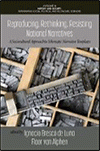
Reproducing, Rethinking, Resisting National Narratives
A Sociocultural Approach to Schematic Narrative Templates
Edited by:
Ignacio Brescó de Luna, Aalborg University
Floor van Alphen, Universidad Autónoma de Madrid
A volume in the series: History and Society: Integrating social, political and economic sciences. Editor(s): Jaan Valsiner, Niels Bohr Professor of Cultural Psychology, Aalborg University. Søren Dosenrode, Aalborg University. Mario Carretero, Universidad Autónoma de Madrid.
Published 2022
In his now classic Voices of Collective Remembering, James V. Wertsch (2002) examines the extent to which certain narrative themes are embedded in the way the collective past is understood and national communities are imagined. In this work, Wertsch coined the term schematic narrative templates to refer to basic plots, such as the triumph over alien forces or quest for freedom, that are recurrently used, setting a national theme for the past, present and future. Whereas specific narratives are about particular events, dates, settings and actors, schematic narrative templates refer to more abstract structures, grounded in the same basic plot, from which multiple specific accounts of the past can be generated. As dominant and naturalised narrative structures, schematic narrative templates are typically used without being noticed, and are thus extremely conservative, impervious to evidence and resistant to change.
The concept of schematic narrative templates is much needed today, especially considering the rise of nationalism and extreme-right populism, political movements that tend to tap into national narratives naturalised and accepted by large swathes of society. The present volume comprises empirical and theoretical contributions to the concept of schematic narrative templates by scholars of different disciplines (Historiography, Psychology, Education and Political Science) and from the vantage point of different cultural and social practices of remembering (viz., school history teaching, political discourses, rituals, museums, the use of images, maps, etc.) in different countries. The volume’s main goal is to provide a transdisciplinary debate around the concept of schematic narrative templates, focusing on how narratives change as well as perpetuate at times when nationalist discourses seem to be on the rise. This book will be relevant to anyone interested in history, history teaching, nationalism, collective memory and the wider social debate on how to critically reflect on the past.
CONTENTS
Series Editor’s Preface: Clandestine Abstraction in National Narratives—Where Psychology and Politics Meet, Jaan Valsiner. Introducing Schematic Narrative Templates as Cultural Tools for Remembering the Past, Ignacio Brescó de Luna and Floor van Alphen. SECTION I: THE POLITICS AND HISTORY OF SCHEMATIC NARRATIVE TEMPLATES. Narrative Templates and Narrative Fissures in Post-Genocide Rwanda: The Susceptible Sur-Face of a Hardwired National Historical Canon, Denise Bentrovato. Historicizing and Pluralizing Wertsch’s Narrative Templates: Freedom and Tolerance in Dutch History Textbooks, Tina van der Vlies. Colonialism and Liberation Struggle in Mozambican History Textbooks: A Diachronic Analysis, Rosa Cabecinhas, Cassimo Jamal, Alberto Sá, and Isabel Macedo. Reconquista or Regaining Spain From the Internal Other: The Continuation of a Dominant Narrative Template in Spanish Collective Memory, Ignacio Brescó de Luna and Floor van Alphen. SECTION II: EDUCATION, YOUTH, AND SCHEMATIC NARRATIVE TEMPLATES. Schematic Templates and Diverse Populations in the United States: Narrative Limitations in Young People’s Understanding, Keith C. Barton. Narrative Templates Disrupted? The (Dis)functioning of Templates in a Nation State in Decline, Karel Van Nieuwenhuyse and Mathieu Bouhon. Schematic Narrative Templates and National Narratives: A Mutually Supporting Relationship and Its Impact on Historical Thinking, Cesar Lopez. SECTION III: VISUAL CULTURE AND SCHEMATIC NARRATIVE TEMPLATES. Imagining the Invasion: Far-Right Visual Schematic Narratives, Anita Nissen, Sarah H. Awad, and Ivan Lind Christensen. Narrating Berber Culture in Moroccan Museums, Norah Karrouche. Images, Maps, and the (De)Stabilization of National Master Narratives in Argentina, Cristian Parellada and María Fernanda González. Mutable and Multilevel Schematic Templates: Narratives of Collaboration Between Finland and Nazi Germany in Finnish History Textbooks, Eemeli Hakoköngäs and Inari Sakki. About the Editors. About the Contributors.
-
Paperback978-1-64802-661-4
Web price: $45.04 (Reg. 52.99)
-
Hardcover978-1-64802-662-1
Web price: $80.74 (Reg. 94.99)
- eBook978-1-64802-663-8

- POL030000 - POLITICAL SCIENCE: AMERICAN GOVERNMENT: National
- PSY031000 - PSYCHOLOGY: Social Psychology
- HIS035000 - HISTORY: Study and Teaching
-
 Beyond the Dichotomy Between Altruism and Egoism
Society, Relationship, and Responsibility
Beyond the Dichotomy Between Altruism and Egoism
Society, Relationship, and Responsibility
-
 Conflicts in History Education in Europe
Political Context, History Teaching, and National Identity
Conflicts in History Education in Europe
Political Context, History Teaching, and National Identity
-
 Educational Justice
Challenges For Ideas, Institutions, and Practices in Chilean Education
Educational Justice
Challenges For Ideas, Institutions, and Practices in Chilean Education
-
 Sensuous Unity of Art and Science
The Times of Rudolf II
Sensuous Unity of Art and Science
The Times of Rudolf II
-
 Sticking Together
How Local Politicians Make Sense of and Respond to International Crises
Sticking Together
How Local Politicians Make Sense of and Respond to International Crises
-
 The Development of Social Knowledge
Towards a Cultural-individual Dialectic
The Development of Social Knowledge
Towards a Cultural-individual Dialectic
-
 Transterradas
Child and Youth Exile as a Place of Memory
Transterradas
Child and Youth Exile as a Place of Memory

